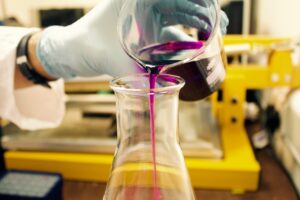Table of Contents
OBJECTIVES
After attending to this experiment, we shall be able to perform the calibration of glassware.
INTRODUCTION
For very accurate volumetric analysis, it is advisable to calibrate the volumetric glassware.
Though a volumetric pipet may be labeled 25 mL, it will not deliver exactly that volume. There are allowed tolerances in manufacture.
For example, a 100 mL volumetric flask is manufactured to a tolerance of ±0.08 mL, and since liquids and glass expand or contract as temperature rises and falls, the tolerance applies at the temperature indicated on the flask, usually 20°C.
CALIBRATION OF GLASSWARE
Calibration of Volumetric Flask
To calibrate a volumetric flask, weigh the clean, dry flask and stopper. Fill it to the mark with distilled water. There should be no droplets on the neck.
If present, blot them with tissue paper. The flask and water should be equilibrated to room temperature. Weigh the filled flask, and then record the temperature of the water to 0.1°C.
The increase in weight represents the weight of water present in the flask. Convert the weight into the volume of water by using suitable density correction at specific temperatures.
Calibration of Pipette
To calibrate a pipette, weigh a dry Erlenmeyer flask with a stopper or a weighing bottle with a glass stopper, depending on the volume of water to be weighed.
Fill the pipette with distilled water and deliver the water into the flask or bottle, note the temperature of the water and quickly stopper the container to avoid evaporation loss. Reweigh to obtain the weight of water delivered by the pipette. Convert the weight into the volume of water by using suitable density correction at specific temperatures.
Calibration of Burette
Calibrating a burette is similar to the procedure for a pipette, except that several volumes will be delivered. The internal bore of the burette is not perfectly cylindrical and so, the actual volume delivered will vary from the nominal volumes marked on the burette, as increased volumes are delivered. You will ascertain the volume at 20% full volume increments by filling the burette each time and then delivering the nominal volume into a dry flask. Typical volume corrections for a 50 ml burette may range up to about ±0.05 ml.
CALCULATION
Weight of Water (in vacuum), g = X1 + X1 × glass expansion =Y1.
Actual volume of water, ml = Y1/density
RESULTS AND INFERENCE
Glassware with calculated correction factors of more than ± 0.05 should not be used.
PRECAUTIONS
- Make sure that the balance is calibrated.
- The thermometer used for measuring the temperature should be calibrated.
- Always tare the balance before use.
- Glassware should be absolutely clean and dry before use

